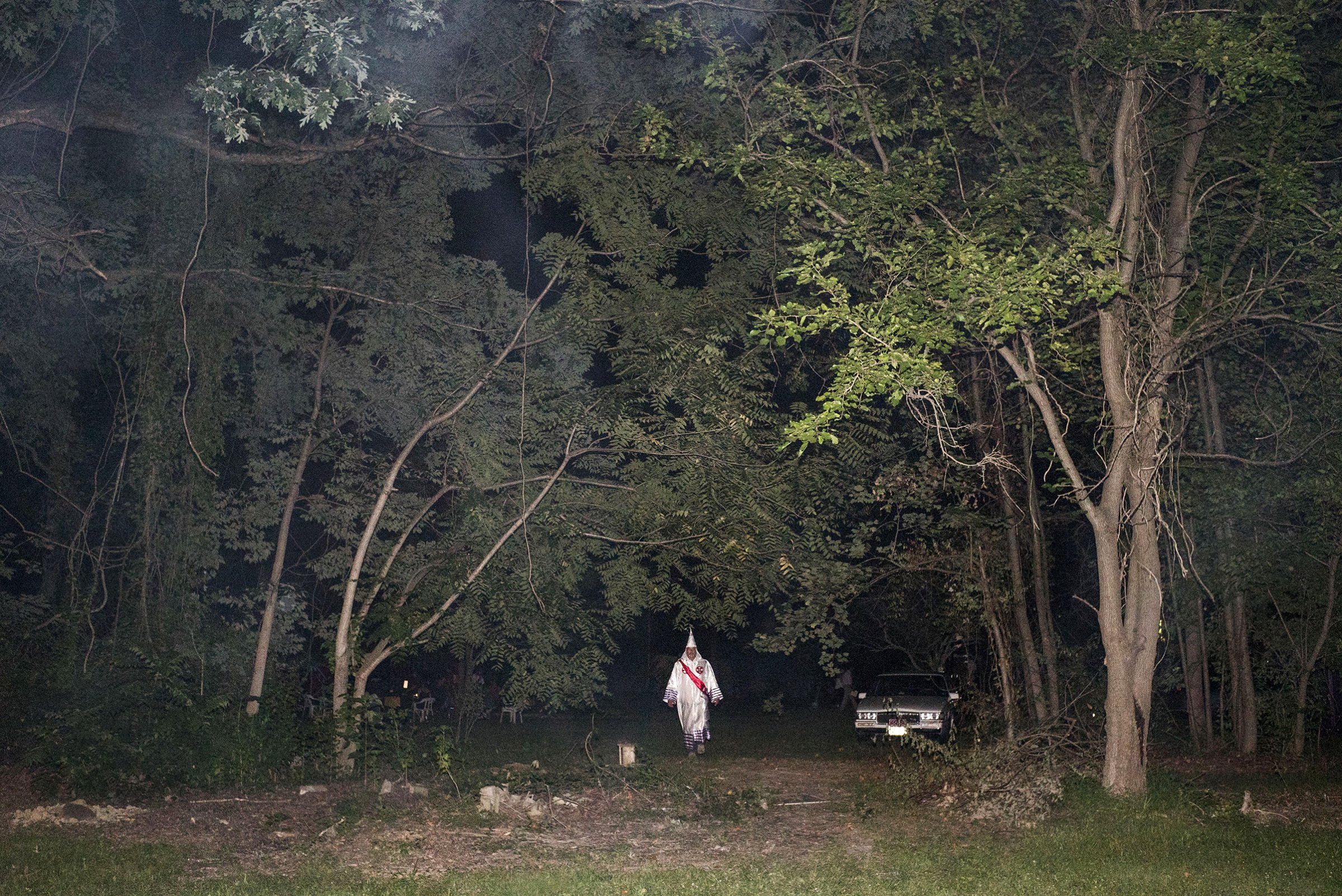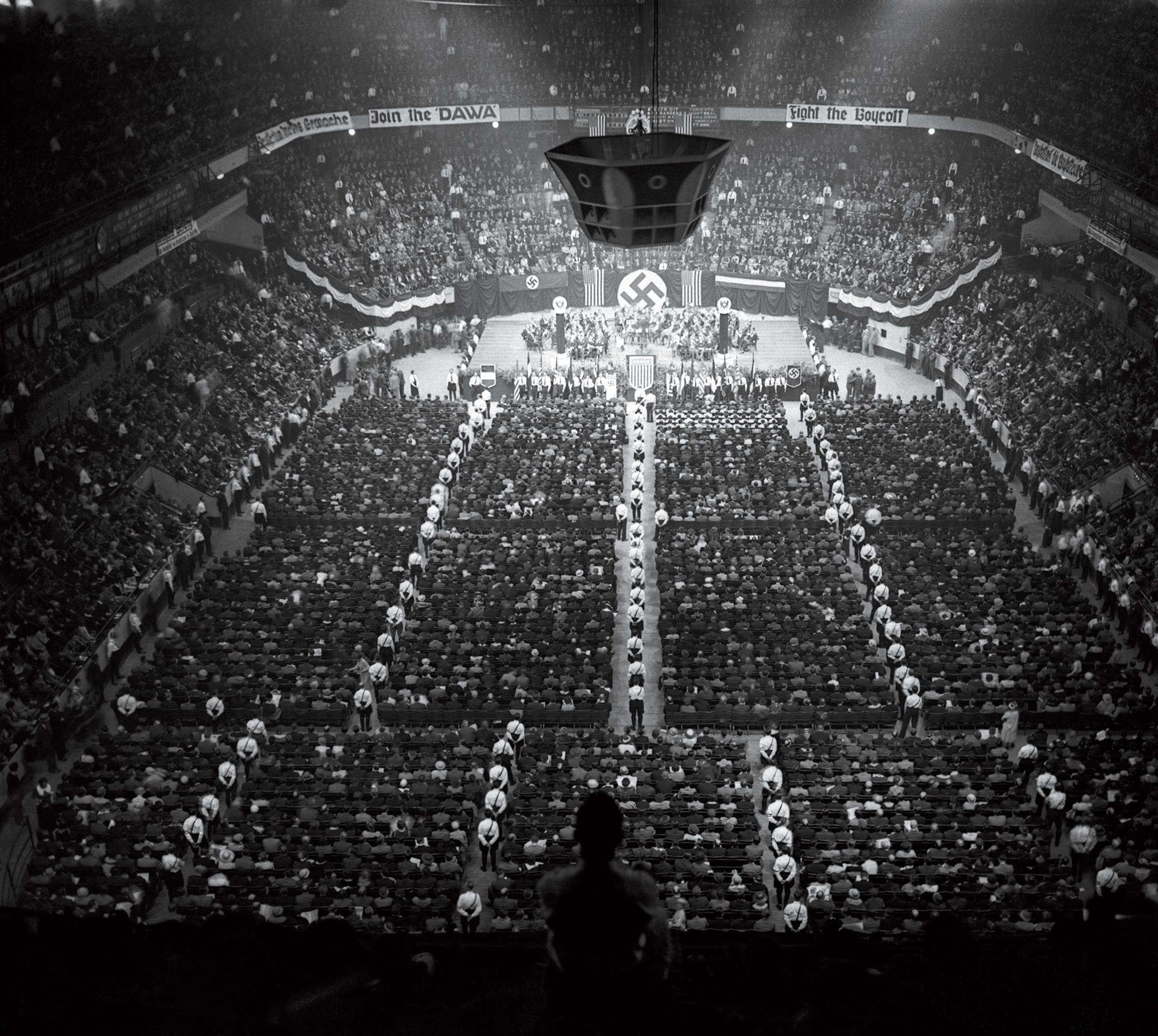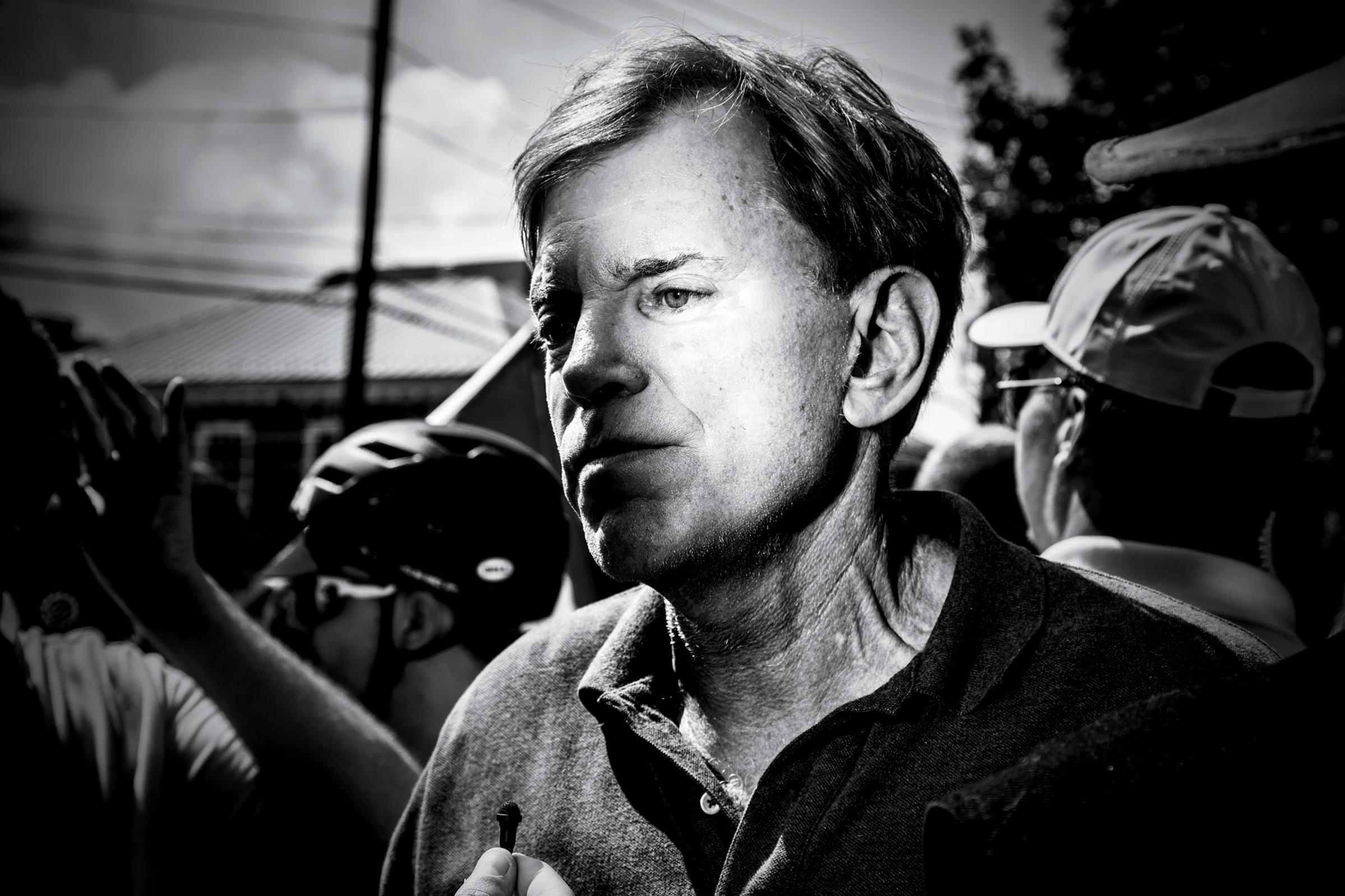
The message was clear. The fate of America — or at least of white America, which was the only America that counted — was at stake. On the autumn evening of Thursday, Oct. 7, 1948, South Carolina Governor Strom Thurmond, the segregationist Dixiecrat nominee for President, addressed a crowd of 1,000 inside the University of Virginia’s Cabell Hall in Charlottesville, Va. Attacking President Truman’s civil rights program, one that included anti-lynching legislation and protections against racial discrimination in hiring, Thurmond denounced these moves toward racial justice, saying such measures “would undermine the American way of life and outrage the Bill of Rights.” Interrupted by applause and standing ovations, Thurmond was in his element in the Old Confederacy. “I want to tell you, ladies and gentlemen,” Thurmond had told the breakaway States’ Rights Democratic Party at its July convention in Birmingham, Ala., “that there’s not enough troops in the Army to force the Southern people to break down segregation and admit the nigra race into our theaters, into our swimming pools, into our homes, into our churches.”
Seventy years on, in the heat of a Virginia August, heirs to the Dixiecrats’ platform of hate and exclusion — Klansmen, neo-Nazis and white supremacists of sundry affiliations — gathered in Charlottesville, not far from where Thurmond had taken his stand. The story is depressingly well known by now: a young counterprotester, Heather Heyer, was killed by a barreling car allegedly driven by a man who was seen marching with a neo-Nazi group. In the wake of Heyer’s death, the President of the United States — himself an heir to the white populist tradition of Thurmond and of Alabama’s George Wallace — flailed about, declining to directly denounce the white supremacists for nearly 48 hours. There was, he said, hate “on many sides,” as if there were more than one side to a conflict between neo-Nazis who idolize Adolf Hitler and Americans who stood against Klansmen and proto–Third Reich storm troopers. Within days Donald Trump had wondered aloud why people weren’t more upset by the “alt-left,” clearly identifying himself with neo-Confederate sentiment.
Perennially latent, extremist and racist nationalism tends to spike in periods of economic and social stress like ours. Americans today have little trust in government; household incomes woefully lag behind our usual middle-class expectations. As the world saw in Charlottesville — and in the alt-right universe of the Web — besieged whites, frightened of change, are seeking refuge in the one thing a shifting world cannot take away from them: the color of their skin.
If the current climate of grievance is of ancient origin, though, the white supremacists’ sense of urgency — indeed of increasing legitimacy — seems new. Today’s fringe sees itself not as a fringe but as the tip of the spear for the incumbent President’s nationalist agenda. “We are determined to take our country back,” said David Duke, former Grand Wizard of the KKK, in Charlottesville. “We are going to fulfill the promises of Donald Trump. That’s what we believed in, that’s why we voted for Donald Trump. Because he said he’s going to take our country back. That’s what we gotta do.”
Perhaps President Trump disagrees, but how to know for certain? He rose in national politics, after all, in part by questioning whether Barack Obama had been born in the U.S., thus capitalizing on, and fueling, the racist and xenophobic reaction to the election of the first African-American President. Now in power, Trump governs for his base, and the alt-right is part of that base — a fact that gives white supremacists a kind of privileged status in the tangled political thickets of Trumpland. He may denounce such groups in the end, but he tends to do so only after confounding caesuras — and even then he equivocates. Why? “Darkness is good,” Trump’s chief strategist, Stephen Bannon, has said. When Joshua Green, the author the new book Devil’s Bargain, asked Bannon about Hillary Clinton’s 2016 attacks on Trump’s popularity among white nationalists, Bannon replied, “We polled the race stuff and it doesn’t matter.”
But it does. To understand where we are, we need to understand the history of hate in America — a history that sheds a good deal of light on how we’ve reached a place in the life of the nation where a former Grand Wizard of the KKK can claim, all too plausibly, that he is at one with the will of the President of the United States.

I. In the Shadow of Defeat: The KKK, Reconstruction and the Bolsheviks
It was Christmas Eve, 1865, in Pulaski, Tenn., barely eight months after Robert E. Lee had surrendered to Ulysses S. Grant at Appomattox Courthouse in Virginia. Gloomy about the failure of the war and anxious about Union-run Reconstruction, six former Confederates founded the Ku Klux Klan in Thomas M. Jones’ law office. The organization’s name was derived from kuklos, the Greek word for ring or circle, and featured elaborate titles, costumes and hoods fashioned from bed linens, and horseback rides through the night.
Over the next few years, the KKK, with Nathan Bedford Forrest as its Grand Wizard, grew in influence and in menace, devoting itself to terrorizing freed African Americans and to undermining Reconstruction authorities. Put down by three federal laws in 1870 and 1871, the Klan dissipated as an active force. Yet its essential aim, the establishment of white supremacy, was achieved in ensuing years with pro-Southern Supreme Court decisions and the withdrawal of federal forces from the Louisiana, South Carolina and Florida statehouses after the disputed 1876 presidential election. That same year, future South Carolina Senator and Governor Ben Tillman, a prominent voice of white supremacy, was part of an attack on African-American Republicans at Hamburg, S.C. “The purpose of our visit was to strike terror,” Tillman recalled in a speech to the Senate in 1900. “And the next morning when the Negroes who had fled to the swamp returned to the town the ghastly sight … of seven dead Negroes lying stark and stiff certainly had its effect.”
By the 1890s, Jim Crow laws were effectively undoing the verdict of Appomattox. In 1894, Mississippi voted to include the Confederate battle emblem on its state flag; two years later, in Plessy v. Ferguson, the Supreme Court sanctioned the principle of “separate but equal.” Within three decades of Lee’s surrender, angry and alienated Southern whites who had lost a war had successfully used terror and political inflexibility to re-create the antebellum world of American apartheid. Lynchings, church burnings and the systematic denial of access to equal education and to the ballot box were the order of the decades.
The novelist Richard Wright vividly captured the realities of life under Jim Crow. “We know that if we protest we will be called ‘bad niggers,'” Wright wrote in a book titled Twelve Million Black Voices. “The Lords of the Land will preach the doctrine of ‘white supremacy’ to the poor whites who are eager to form mobs. In the midst of general hysteria they will seize one of us — it does not matter who, the innocent or guilty — and, as a token, a naked and bleeding body will be dragged through the dusty streets … The Ku Klux Klan attacks us in a thousand ways, driving our boys and girls off the jobs in the cities and keeping us who live on the land from protesting or asking too many questions.”
The white supremacists’ enmity was not limited to blacks. During World War I and in the years after the Bolshevik Revolution of 1917, a resurgent Klan, boosted in part by the movie The Birth of a Nation, targeted immigrants, Roman Catholics and Jews. The fear was that the “huddled masses” of Emma Lazarus’ poem would destroy the America that whites had come to know. As cities swelled with people of diverse ethnic and religious backgrounds — immigrants thought to be agents of a global communist conspiracy — the decline of familiar farm life gave new force to the Klan, which staged massive marches down Pennsylvania Avenue in Washington in 1925 and 1926.
II. Ashes of the Reich: The Rise of Neo-Nazism
On Thursday, Sept. 11, 1941, Charles Lindbergh — American aviation hero and leading isolationist — stepped to the microphones at an America First Committee rally in Des Moines, Iowa. He had long taken it upon himself to speak, as he had once put it, for “that silent majority of Americans who have no newspaper, or newsreel, or radio station at their command.” Now it was time, he had decided, to make himself very clear on what he saw as a critical issue facing the nation as it debated whether to go to war against Adolf Hitler: the role of American Jews. “No person with a sense of the dignity of mankind can condone the persecution of the Jewish race in Germany,” Lindbergh said in Des Moines. “But” — and the but here is epochal — “no person of honesty and vision can look on their pro-war policy here today without seeing the dangers involved in such a policy, both for us and for them … Their greatest danger to this country lies in their large ownership and influence in our motion pictures, our press, our radio and our government.”
Outright Nazi sympathy was evident in America in the prewar years. “When we get through with the Jews in America,” Father Charles Coughlin, the anti-Semitic radio priest, said, “they’ll think the treatment they received in Germany was nothing.” Pro-Nazi groups held huge rallies at Madison Square Garden; one sponsored by the German-American Bund in February 1939 featured a 20,000-strong crowd chanting cries of “Heil Hitler.”
Isolationism was a complex phenomenon, but fear was a fairly common theme among its disparate elements: fear of entanglement; fear of sacrificing American blood and treasure for the advantage of others; fear of putting foreign demands ahead of national needs. Even after Pearl Harbor and Hitler’s declaration of war on the U.S. in December 1941, there were still those who peddled a toxic blend of anti-Semitism (which came to include Holocaust denial) and virulent anticommunism and racist ideology. Eventually, Cold War anxieties were oxygen to the flames of neo-Nazism. Just as the Klan had benefitted from the fears of the 1920s after the Russian Revolution, white supremacists after World War II linked their cause with the apocalyptic rhetoric of right-wing anticommunism. These were the years of Joseph McCarthy and of the John Birch Society, of IMPEACH EARL WARREN billboards and White Citizens’ Councils. In a November 1963 lecture that formed the basis, a year later, of a Harper’s cover story and later a book, “The Paranoid Style in American Politics,” the historian Richard Hofstadter discerned a pattern of extreme conspiratorial theories about fundamental threats to the country.
“The paranoid spokesman … traffics in the birth and death of whole worlds, whole political orders, whole systems of human values,” Hofstadter wrote. “He is always manning the barricades of civilization. He constantly lives at a turning point: it is now or never in organizing resistance to conspiracy.” Ranging from fears of the Bavarian Illuminati in the 1790s to the dark anxieties of the anticommunists of the 1960s, Hofstadter identified the recurrent tendency to see powerful forces at work to undermine American life or politics or, often, both. (Immigrants, Jews and international bankers were favorites.) Hofstadter’s point: there’s always a war on to make America great again, for there are always those who believe American greatness is under assault from “the other.”

III. ‘Segregation Forever’: Defiance Resurgent
In the South in particular, race, as ever, was the flash point. In 1948, when Minneapolis Mayor Hubert H. Humphrey called on the Democratic National Convention in Philadelphia to walk into the “sunshine of human rights,” Thurmond and his fellow segregationists marched out of the hall, went South and met at Birmingham to form the Dixiecrat ticket. Worried about communists and civil rights — President Truman integrated the military the same month as the Dixiecrat rebellion — the disaffected began to carry Confederate battle flags to rallies, seeking to link their cause with the Lost one.
After the school-integration decisions of the mid-1950s, defiance was pervasive. Georgia incorporated the Confederate battle emblem into its flag in 1956, and South Carolina hoisted the Confederate colors over its Capitol in 1961. By 1964, Alabama Governor George Wallace, the man who had promised “segregation forever,” was taking a Southern white populism to the national stage.
Wallace brought something intriguing to the modern politics of hate in America: a visceral connection to his crowds, an appeal that confounded elites. The cigar-chewing bantam figure with slicked-back hair was “simply more alive than all the others,” a female journalist told the writer Marshall Frady, a Wallace biographer. Alluding to a Wallace speech in New Hampshire, the woman continued, “You saw those people in that auditorium while he was speaking — you saw their eyes. He made those people feel something real for once in their lives. You can’t help but respond to him. Me — my heart was pounding. I couldn’t take my eyes off him, there were all those people screaming. You almost love him, though you know what a little gremlin he actually is.”
IV. In Our Time
Hate will be with us always, but it need not become a defining feature of a given era. In 1995, when Timothy McVeigh bombed the federal building in Oklahoma City, leaders of both major parties stood up. “Let us let our own children know that we will stand against the forces of fear,” President Clinton told mourners. “When there is talk of hatred, let us stand up and talk against it. When there is talk of violence, let us stand up and talk against it. In the face of death, let us honor life.” In those dark weeks, the National Rifle Association defended a recent fundraising letter that targeted not the murderers of innocents but federal agents the gun lobby’s leadership derided as “jackbooted Government thugs.” Reading the missive, former President George H.W. Bush, a life member, resigned from the group. “To attack Secret Service agents or A.T.F. people or any government law enforcement people as ‘wearing Nazi bucket helmets and black storm-trooper uniforms’ wanting to ‘attack law-abiding citizens,'” Bush wrote, “is a vicious slander on good people.” The same spirit animated George W. Bush when, six years later, he insisted that America’s war on terror was not a war against all of Islam. “The terrorists,” Bush 43 said, “are traitors to their own faith, trying, in effect, to hijack Islam itself.”
Such presidential grace can be crucial in ameliorating moments of virulence and violence. We tend to be more likely to choose the right path when we’re encouraged to do so from the very top. Franklin D. Roosevelt once observed that the presidency is “pre-eminently a place of moral leadership,” and the country has come to look to the White House for a steadying hand in stormy times of unease and vitriol.
At the moment, we look in vain. Going forward, white supremacists are likely to repeat the strategy of Charlottesville. The march last weekend was ostensibly about demonstrating support for a Robert E. Lee memorial that’s slated for removal. Now freshly emboldened, organizers are planning demonstrations in Boston and San Francisco, and in the South the sheer number of Confederate memorials offer white nationalists a target-rich environment. Old times are truly not forgotten, and it seems safe to say that they won’t be anytime soon. At least not in Trump’s America.
—With reporting by ABIGAIL ABRAMS/NEW YORK
More Must-Reads from TIME
- Caitlin Clark Is TIME's 2024 Athlete of the Year
- Where Trump 2.0 Will Differ From 1.0
- Is Intermittent Fasting Good or Bad for You?
- The 100 Must-Read Books of 2024
- Column: If Optimism Feels Ridiculous Now, Try Hope
- The Future of Climate Action Is Trade Policy
- FX’s Say Nothing Is the Must-Watch Political Thriller of 2024
- Merle Bombardieri Is Helping People Make the Baby Decision
Contact us at letters@time.com